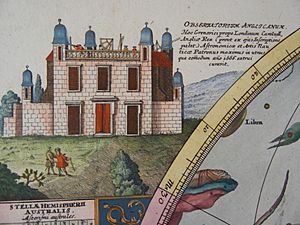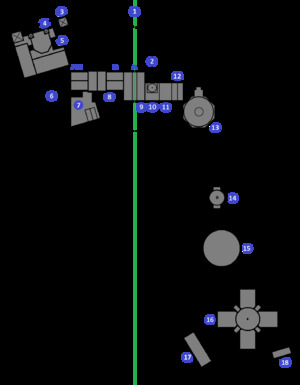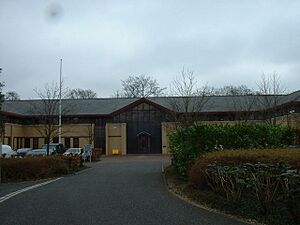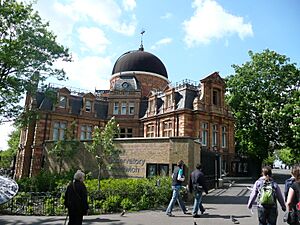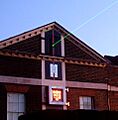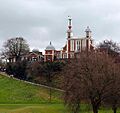Royal Observatory, Greenwich facts for kids
| Location | Greenwich, London, England |
|---|
The Royal Observatory, Greenwich (often called ROG) is a famous building on a hill in Greenwich Park in south east London. It looks over the River Thames. This observatory was super important in the history of astronomy (studying space) and navigation (finding your way).
It's also where the Prime Meridian passes through. This imaginary line helped create Greenwich Mean Time (GMT), which was a very important way to tell time for the whole world. Today, we use something called Coordinated Universal Time (UTC), which is similar. The ROG is part of a group of museums called Royal Museums Greenwich.
King Charles II ordered the observatory to be built in 1675. The first stone was laid on August 10th. Sir Christopher Wren, a famous architect, chose the spot. It was on the old site of Greenwich Castle because it was already royal land. The King also created the job of Astronomer Royal. This person would lead the observatory and work hard to map the stars. This was to help sailors find their exact location at sea. John Flamsteed was the very first Astronomer Royal. The building was finished in 1676 and is often called "Flamsteed House" after him.
Over time, the observatory's scientific work moved to other places. Today, the Greenwich site is mostly a museum. However, a new telescope called the AMAT telescope started working there for research in 2018!
Contents
- History of the Royal Observatory
- Key Moments in Time
- The Observatory's Location
- How the Observatory Started
- Mapping Stars for Navigation
- The Greenwich Meridian
- Greenwich Mean Time (GMT)
- The Greenwich Time Ball
- Late 1800s at the Observatory
- Moving the Observatory
- The Observatory in Cambridge and its Closure
- Greenwich Site Active Again
- Magnetic Observations
- Observatory Museum
- Images for kids
- See also
History of the Royal Observatory
Key Moments in Time
- 1675: King Charles II officially started the Royal Observatory on June 22nd. Construction began on August 10th.
- 1714: The Longitude Act was passed. It offered rewards to anyone who could find a way to accurately measure longitude at sea.
- 1767: The fifth Astronomer Royal, Nevil Maskelyne, started publishing The Nautical Almanac. This book helped sailors navigate using observations from the Observatory.
- 1833: The Observatory began sending daily time signals by dropping a time ball.
- 1852: Time signals were also sent out using telegraph lines.
- 1884: An international meeting in Washington D.C. decided that the Greenwich Prime Meridian would be the world's main meridian.
- 1893: The powerful 28-inch Great refractor telescope was installed.
- 1924: The Royal Observatory first broadcast hourly time signals, known as the Greenwich Time Signal.
- 1957: The Royal Observatory finished moving all its operations to Herstmonceux in East Sussex. The Greenwich site was then called the Old Royal Observatory.
- 1998: The Royal Greenwich Observatory (RGO) closed. The Greenwich site got its original name back and became part of the National Maritime Museum.
- 2011: The museums in Greenwich, including the ROG, became known as the Royal Museums Greenwich.
The Observatory's Location
This land has a long history. Greenwich Palace, where the National Maritime Museum is now, was where Henry VIII and his daughters Mary I and Elizabeth I were born. The Tudors used Greenwich Castle, which was on the same hill as the Observatory, as a hunting lodge.
In 1676, the main building of the observatory, now called Flamsteed House, was completed on Greenwich hill.
How the Observatory Started
Sir Jonas Moore suggested building a Royal Observatory in 1674. He convinced King Charles II to create it, with John Flamsteed as its first director. The building was designed by Sir Christopher Wren, possibly with help from Robert Hooke. It was the first building in Britain made just for scientific research. It cost about £520, using mostly recycled materials.
Moore also gave two special clocks, made by Thomas Tompion, for the main Octagon Room. These clocks had very long pendulums and were incredibly accurate for their time. They were only off by about seven seconds a day!
The observatory was home to the Astronomer Royal, his assistant, and their families. It also held the scientific tools Flamsteed used to map the stars. Over time, the observatory grew. It started publishing The Nautical Almanac, giving advice to the government, sending out time signals, and making weather and magnetic observations.
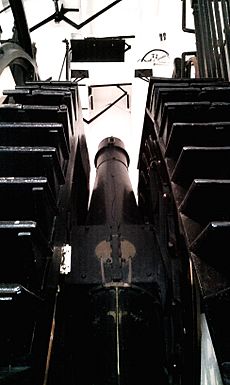
When the observatory began in 1675, the best star maps weren't good enough for sailors to find their exact longitude. One of Flamsteed's first jobs was to create much more accurate star charts.
Later, James Bradley, the third Astronomer Royal, mapped sixty thousand stars between 1750 and 1762. His maps were so good they were still used in the 1940s!
In 1835, George Biddell Airy became Astronomer Royal. He wanted even better instruments. He installed a special telescope called a transit circle in 1851. This instrument was used for a century to precisely measure star positions. It helped astronomers figure out the exact time and location of stars.
The Greenwich Meridian

British astronomers have always used the Royal Observatory as a starting point for measurements. The most famous line, the meridian that goes through the Airy transit circle, was chosen as the world's Prime Meridian in 1884. This happened at a big meeting in Washington, D.C. For about a century, countries all over the world used this line for their maps and timekeeping.
Today, a powerful green laser shines north from the Observatory at night to mark the Prime Meridian.
It's interesting to know that the exact location of the Prime Meridian has changed slightly over time. Modern technology uses a more precise global reference system called the IERS Reference Meridian. This new meridian is about 102.5 meters east of the old Greenwich astronomical meridian.
Greenwich Mean Time (GMT)

The Airy Transit Circle (ATC) was a key instrument for telling time from 1851 to 1938. It was decided that the "meridian line marked by the cross-hairs in the Airy Transit Circle eyepiece would indicate 0° longitude and the start of the Universal Day." Astronomers would watch a star of known location pass through the telescope's aimpoint to determine the exact time.
By 1925, there was some confusion about whether GMT started at noon or midnight. So, in 1928, astronomers decided to use a new term called Universal Time (UT) instead of GMT for scientific purposes. In 1957, the observatory stopped measuring time.
Even though it's not measured there anymore, the term "GMT" is still popular in the UK. Today, we use Coordinated Universal Time (UTC) as the basis for civil time. It combines the best parts of Universal Time (UT1) and International Atomic Time (TAI), which is kept by super accurate clocks.
The Greenwich Time Ball
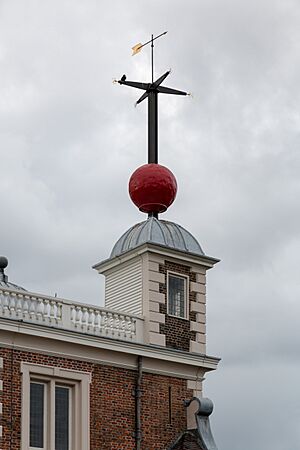
The famous red time ball at Greenwich was first used in 1833. It was a public signal to tell the time. Today, the ball usually rests in a lowered position. At 12:55 pm, it starts to rise. By 12:58 pm, it reaches the top. Then, exactly at 1 pm, the ball drops!
This allowed sailors on the River Thames and others who could see the observatory to set their clocks to GMT. The Astronomer Royal John Pond installed it. At first, an operator dropped it. From 1852, it was released automatically by an electric signal from the Shepherd Master Clock. The ball still drops every day at 1 pm (GMT in winter, BST in summer).
The original time ball system cost £180. The ball was five feet wide and made of wood and leather. It was very popular with the public, sailors, and clock makers.
Late 1800s at the Observatory
The 1890s saw the addition of a new, larger telescope: the 28-inch Grubb refractor. It was placed in the Great Equatorial Dome. Because this new telescope was longer, the dome had to be bigger. This is why the famous "onion dome" was built.
The telescope was installed by 1893. Its 28-inch glass lens was made by Grubb. The new dome was built by T. Cooke and Sons.
An interesting event happened on February 15, 1894. There was an attempted bombing at the Observatory. A 26-year-old French anarchist named Martial Bourdin accidentally set off a bomb in Greenwich Park near the Observatory. He died shortly after. No one knows why he chose the observatory or if the bomb was meant to go off somewhere else. The writer Joseph Conrad used this event in his 1907 novel The Secret Agent.
Moving the Observatory
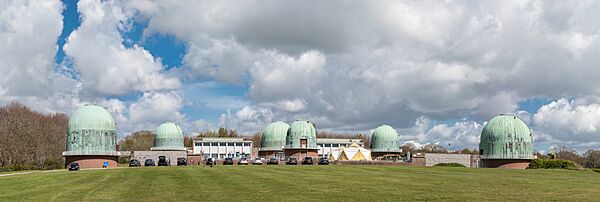
For much of the 20th century, the Royal Greenwich Observatory wasn't actually in Greenwich. It moved to Herstmonceux in East Sussex in 1957. This move happened because electric railways in London were affecting the observatory's magnetic readings. Also, light pollution from the city made it harder to see the stars.
During World War II, many departments were moved away from London to avoid German bombs. On October 15, 1940, during the Blitz, a bomb hit the Courtyard gates, damaging the Gate Clock.
After the war, in 1947, the decision was made to move the entire Royal Observatory to Herstmonceux Castle. The Astronomer Royal, Harold Spencer Jones, moved there in 1948. The scientific staff followed in 1957 when the new buildings were ready. The largest telescope from Greenwich, the 36-inch Yapp telescope, was moved to Herstmonceux in 1958.
A new, powerful telescope called the Isaac Newton Telescope was opened at Herstmonceux by Queen Elizabeth II in 1967. It was the biggest telescope in the British Isles. However, the cloudy weather in England made it hard to use it to its full potential. So, in 1979, it was moved to a better location in the Canary Islands in Spain.
In 1990, the Royal Greenwich Observatory moved again, this time to Cambridge. The castle grounds at Herstmonceux became a science center for visitors.
The Observatory in Cambridge and its Closure
In 1990, the Royal Observatory moved to Cambridge, next to the University's Institute of Astronomy. Here, the observatory focused on providing technical support to British scientists using powerful telescopes in places like the Canary Islands and Hawaii.
However, the funding body decided to close the institution. The Royal Greenwich Observatory officially closed in 1998. Some of its work, like the HM Nautical Almanac Office, moved to other research centers. The old observatory site in Greenwich then returned to its original name and became part of the National Maritime Museum.
Greenwich Site Active Again
In 2018, the Annie Maunder Astrographic Telescope (AMAT) was installed at the ROG in Greenwich. This is a group of four telescopes used for astronomical research. It includes:
- A 14-inch telescope for high-resolution images of the sun, moon, and planets.
- A special instrument just for observing the sun.
- A telescope with different filters to view distant nebulae.
- A general-purpose telescope.
These new telescopes and the work to install them cost about £150,000. They are controlled by a computer system from the Altazimuth Pavilion.
Magnetic Observations
The first magnetic observation was made in 1680 by John Flamsteed. In the 19th century, George Biddell Airy created the Magnetical and Meteorological Department.
Special buildings were constructed using non-magnetic materials to house sensitive magnetic instruments. This was important because iron in other observatory buildings could interfere with the measurements.
Observatory Museum
The observatory buildings in Greenwich are now a museum. It's part of the Royal Museums Greenwich. You can see many amazing exhibits there.
One famous exhibit is John Harrison's pioneering marine chronometer, known as H4. This clock was incredibly accurate and helped sailors find their longitude at sea. Harrison received a large reward for it! You can also see his three earlier timekeepers.
The museum also has many other clocks and instruments that show the history of precise timekeeping. You can see the 28-inch Grubb refracting telescope from 1893, which is the largest of its kind in the UK. Outside the gate, the Shepherd Gate Clock is an early example of an electric clock.
In February 2005, the museum started a big £16 million project to add a new planetarium and more display areas. The ROG reopened on May 25, 2007, with the new 120-seat Peter Harrison Planetarium.
The museum is very popular, with millions of visitors each year. In July 2024, Royal Museums Greenwich announced plans to make the visitor experience even better.
Images for kids
-
Flamsteed House overlooking Greenwich Park. The statue is of Major General James Wolfe.
-
Aerial view of the Royal Greenwich Observatory at Herstmonceux. The dome on the right used to house the Isaac Newton Telescope.
-
A laser projected from the observatory marking the Greenwich Prime Meridian line (1999).
-
The Queen's House (center left) with the Royal Observatory behind it (2017).
-
Imperial standard lengths on the wall of the Royal Observatory.
-
Dome of the Great Equatorial Building overlooking Greenwich Park.
See also
 In Spanish: Real Observatorio de Greenwich para niños
In Spanish: Real Observatorio de Greenwich para niños
- List of astronomical observatories


